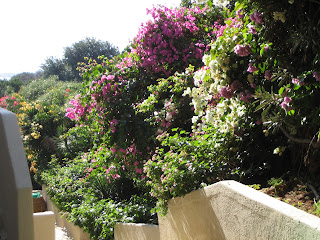I'm afraid the garden wasn't really red, white and blue for the Diamond Jubilee. It was more pink, purple and yellow. There was some white, the cow parsley and white camassias, and some blue, from the last of the brunnera and forget-me-nots (and the perennial cornflower and first of the veronica flowers). Red, however, was only represented by a single sodden and battered poppy flower, barely visible among the leaves; and, less desirably, by the first of the year's lily beetles on the lily nearby (they were duly squashed). The poppies are now flowering (when the weather will let them), while the brunneras have been cut back to prevent self-seeding and the cow parsley and forget-me-nots pulled up. I've lived with cow parsley in the past as it really is quite pretty, but now that we've cleared the view down into the field beyond the bottom of the garden (which is full of the stuff) I don't feel the need to host it in my own space in the same way.
The weather for the Jubilee weekend was miserable. The Monday was dry (though chilly), which was good for the village celebrations, but the Tuesday was very wet and windy, and cold - we put the central heating back on (and it has been on all the way through to this week, when we finally had a couple of sunny and warmish days). The sun has been pleasant when it has shone, but otherwise it has been rather unpleasant, with some high winds which produced a whole bagful of kindling brought down from the ash trees, and knocked some of the flower stems around. At least I haven't needed to refill the pond with all the rain.
The aquilegias - the old-fashioned ones - are mostly past now, but my two posh ones (a purchase from the village plant sale a couple of years ago) are still going strong, though they've had to be propped up against the wind. The foxgloves are doing well, as is the sweet rocket, and the old roses are just starting to come into flower. More rain and wind is forecast, so they are all going to take a battering, sadly.
On the wildlife front, we have been trying to outwit the squirrel. He hadn't been much in evidence, so I decided to risk removing the squirrel-guard from the peanut container. Although most of the birds have worked out how to use it, they seemed to consider it too much trouble to get inside the guard, and were ignoring it. All went well for a week or so, with the tits, finches and woodpeckers (adults and at least two youngsters) coming to feed, until our furry friend returned. The guard went back on (and interestingly the birds continue to come to it, even the woodpeckers, who can get their heads inside). The squirrel made several determined, but fruitless, attempts to get inside the guard; his lack of success obviously put him in a very bad mood, and he tried to chase any bird that came near (including an attempt to pounce on a pheasant that was passing underneath) before transferring his attention to the seed feeder. After a few tries, we've hit on hanging the seeds from a wire which is too long for him to stretch down, and he has gone away again.
One thing we wish would go away is magpies. We haven't had them for years, but now that the local farm is in new hands they don't seem to control them so effectively. A pair have raided at least one nest - a thrush's, we think, as we saw a magpie with a brown fledgeling of thrush size, and certainly the thrushes haven't been around nearly so much. The blackbirds are continuing to breed, however, with at least two youngsters around, and we've seen a baby robin and baby goldfinch as well as the usual young sparrows. A pair of linnets have been in the garden, and a bullfinch (which is fine as long as he leaves the plums alone!). There's also a family of wrens down at the bottom of the garden, which is lovely.
D's sightings while out running in the lanes include a record of 6 hares in one day, and a near-collision with a deer which was coming out of a field entrance. Fortunately that's one animal we don't get in the garden!















